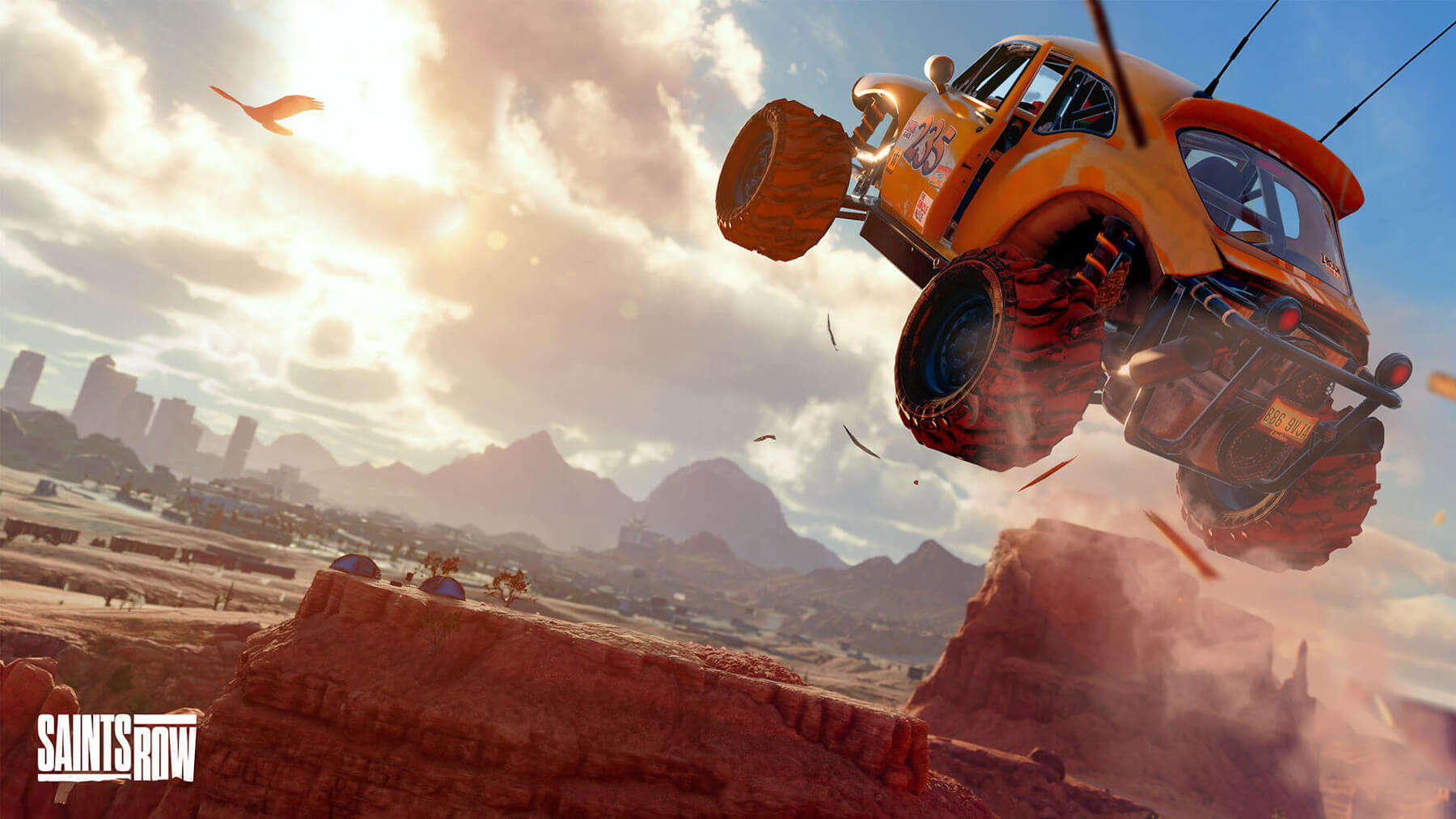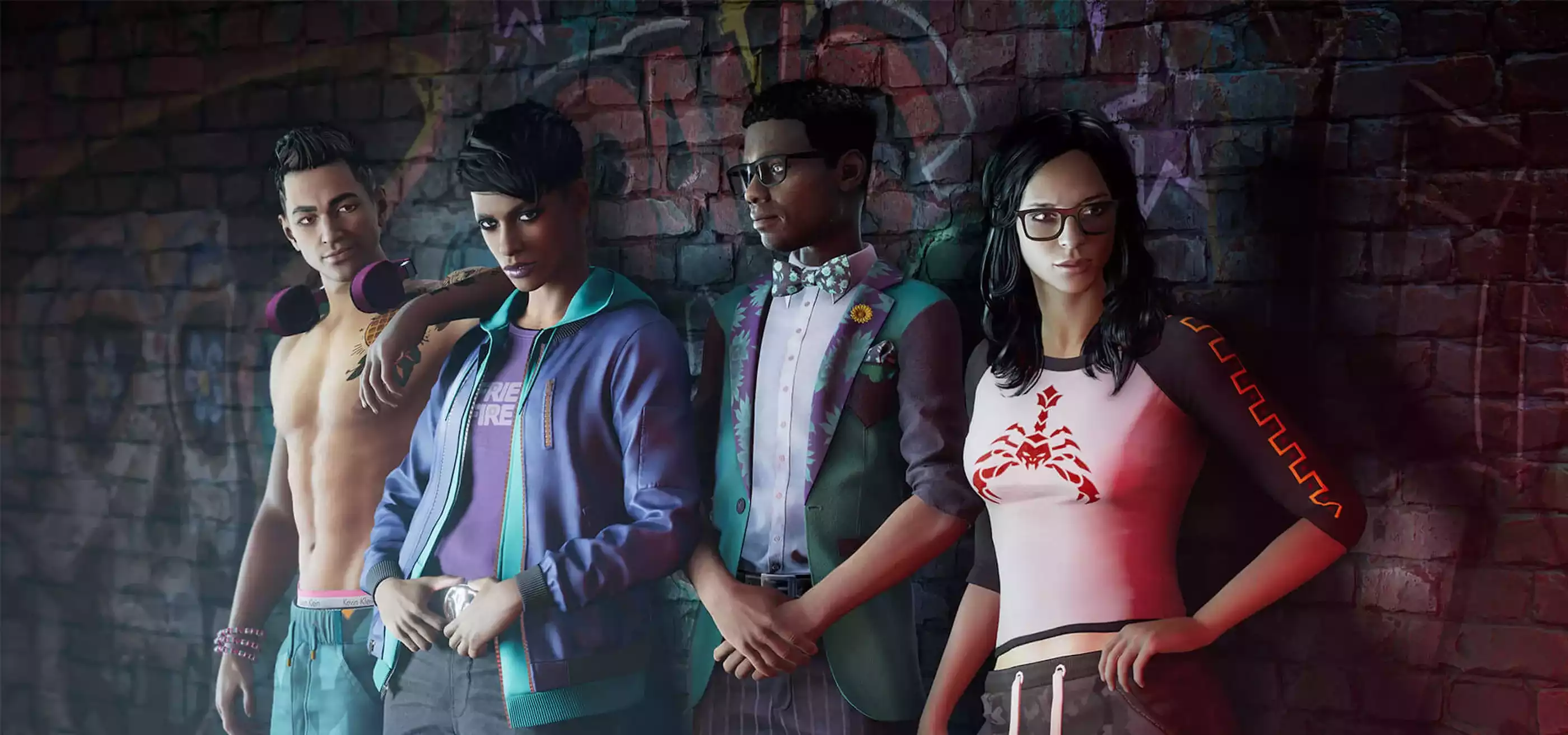If you’ve ever played a game in the Saints Row series, you know all about the joyous mayhem and destruction that comes with building your criminal empire. You also know that, at their heart, the Saints Row games are really about friendship, belonging, and individuals working together as part a highly skilled team.
When it comes to the actual team of people responsible for making the Saints Row games, DigiPen graduates Jeff Keely (2003, BS in Computer Science in Real-Time Interactive Simulation) and Ryan Spencer (1998) are about as OG as it gets. They’ve both been working as programmers at Deep Silver Volition, the studio behind Saints Row, since before the series debuted.
Lately, they’ve been building the tools and gameplay systems to support the highly anticipated Saints Row reboot, which launches today on PC and consoles. Set in a brand new location inspired by the American Southwest, the new game sees you taking on the role of “The Boss.” The self-appointed leader of a scrappy band of outlaws, your aspirations are nothing less than to become the dominant criminal enterprise in the city of Santo Ileso.

“Scrappy” is very much the story of Volition as well, which operates with a workforce of only about 200 employees. Compare that to a studio like Rockstar Games, whose 2018 open-world adventure Red Dead Redemption II was reportedly developed by a team of approximately 1,600 people.
“For our budget and team size, it’s always felt like we’re the underdogs,” Keely says. “We tend to swing above our weight class quite a bit.”
Consider the fact that Volition also develops its own in-house game engine and support tools from scratch, and it’s all the more impressive when you stop and look at what their team has managed to accomplish over the years.

“At the end of the day, you have this end goal,” Spencer says. “Inevitably it’s over-scoped, and you don’t have enough resources. And so the only way you get the best game out of it is if everyone does their part and they do it well.”
For Spencer — who graduated from DigiPen’s early game programming diploma program in Vancouver, Canada — doing his part has meant many different things over the years. Upon joining Volition in 2004, his very first role was audio programming for the original Saints Row game. From there, he quickly rose through the ranks, taking on a lead gameplay programming role for Saints Row 2 — a job that put him in charge of the team responsible for all mission and activity-related programming. He then climbed even higher up the ladder, eventually serving as project technical director for two of the studio’s major titles, 2011’s Red Faction: Armageddon and 2014’s Saints Row IV.
The latter game was a pivotal one for the Saints Row franchise, taking the series in a wildly campy direction as the player becomes the president of the United States shortly before the Earth’s population is abducted by aliens.
“That happens to be my favorite Saints Row,” Spencer says, pointing to the game’s inventive mechanics that let players traverse the open world like superheroes. “Just something about being able to run on water.”
For the new reboot, Spencer’s area of focus has been a little more grounded, dealing mainly with vehicular gameplay and customization. This time around, he says, the development team has been aiming for a style of gameplay that captures the best elements from Saints Row 2 and Saints Row: The Third — the two games most often cited as fan favorites.
“I don’t know what else to say other than it’s fun, it’s big, and I think it’s going to be enjoyed by a lot of people,” Spencer says.

If Keely has demonstrated anything during his own career at Volition, it might be his knack for solving large-scale problems. Since getting his start with the studio in 2005, he too has taken on some key leadership roles, serving as gameplay programming lead on Red Faction: Armageddon and associate project technical director on 2017’s Agents of Mayhem, among other credits.
“When I got here, the first thing they did was turn me on to creating a new world editor that we would use for Red Faction: Guerrilla,” Keely says. “That was a big challenging task to just jump in on day one. It was like, ‘Here’s a tiny framework of a couple hundred lines of code to start with. Create us a whole world editor.’”
Today, as a member of Volition’s core technology group, he works on the systems and tools that support other developers within the studio. “I’m not directly building the game, so the people I need to please and take care of are the mission designers, the world builders, and the environment artists,” Keely says.
Sometime around the end of development on Saints Row IV, Keely began working on what would become one of his biggest multi-year projects to date. It was an all-new visual-based scripting editor, used by Volition’s game designers to test and create various types of in-game content without having to lean on the help of fellow programmers.
“That was probably the most important aspect that I focused on for the scripting system, that they would be self-sufficient and able to do the full loop of development to get their idea into the game world,” Keely says. “We’ve got to really focus on working smarter, not harder, and try to make our tools amplify people’s skills and knowledge as much as possible so that one person can do the work of 100 people.”
Over time, along with plenty of iteration, the new system became a powerful tool indeed. After handing off an early version of the scripting editor to the studio’s designers, they quickly came back with a number of clever prototypes that surprised even Keely.
“Somebody had built a random dungeon generator and some sort of haunted house game,” he says. “A lot of new groups were able to just go crazy, with all of our designers doing insane things in scripting.”
The tool became an integral component in the development of Agents of Mayhem, a quasi-spinoff of the Saints Row franchise.
“We did end up changing some things after that project,” Keely says. “We felt it was super powerful and great for prototyping purposes, but we needed to rein it in at least somewhat.”

Now that those same tools have had more time to be ironed out and polished, Keely says it’s been exciting to see the impact his technology group has had on the development of the new Saints Row.
“We tend to have off-the-wall, crazy mission stuff. There’s hardly any boilerplate, just-do-the-same-thing mission,” he says. “It can be really interesting to see what they have done with these tools that we’ve given them, and you start seeing things like, ‘Oh, we’ve got a coyote cannon now!’”
While the two graduates have come a long way from their days at DigiPen, they both credit their education for equipping them with the knowledge and skills that allowed them to flourish once they landed their jobs at Volition.
“One of the best things about DigiPen was that we created game projects where we were artist, designer, and programmer. It helped give an understanding of what an artist or a designer may desire to achieve,” Spencer says. “It really helps to bridge the gap of where they’re coming from and translate that vision into content that not only looks great but is also fun and entertaining.”
In Keely’s experience, it was quickly apparent how much he had picked up at DigiPen once he started working professionally.
“Just comparing myself to some of the other coworkers I had, it was like, well, there are these things he just doesn’t know, but I learned this at DigiPen,” Keely says. “I believe it sped my career progression up considerably, where I was able to zip right through quite a few promotions at a much more rapid pace than people who didn’t go to a place like DigiPen.”
